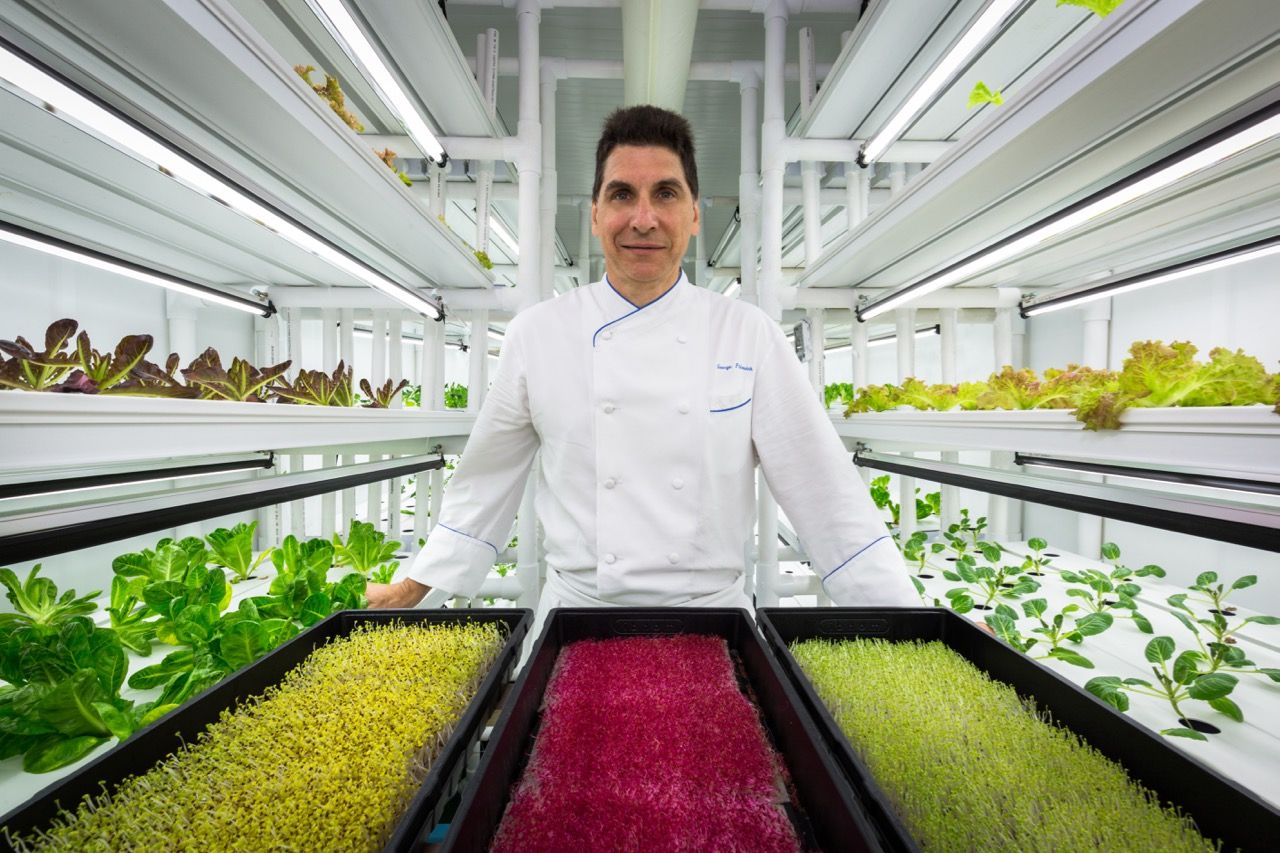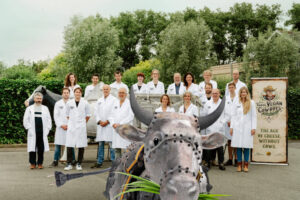A few weeks ago, The Ritz-Carlton, Naples hotel in Florida did something unusual for the high-end hospitality industry: it started farming.
But perhaps not farming in the obvious sense. The hotel has constructed an on-site indoor hydroponic vertical growing system inside a repurposed shipping container. Dubbed “The Grow House”, the farm will produce a large portion of the greens that the hotel serves at its restaurants, from romaine lettuce, cilantro and arugula, to spinach, cabbage and assorted micro-greens.
Using a 44-foot Williamson Greenhouses trailer, and a sensory grow room controller software system by Growtronix, the hotel’s head chef George Fistrovich has found that sourcing fresh, local, and organic greens is not only possible for hotels and restaurants, but relatively simple.
“With The Grow House, the computer takes care of everything. It’s not that complicated—and you don’t have to worry about the elements, which are farmers’ biggest challenge,” Fistrovich told AgFunderNews.
Using temperature control and hydroponics, The Grow House can produce 30,000 heads of lettuce per year. It uses roughly 10 kilowatts of power, and eight gallons of water per day. According to Fistrovich, the current growing cycle of his operation runs between 28-32 days from seed to full-grown plant.
“It’s the perfect environment for growing lettuce,” says Fistrovich. “Especially considering that we are growing lettuce in Florida during August when it’s 105 degrees outside with 90 percent humidity.”
With a range of investors and big-name companies like The Ritz-Carlton sewing roots in the sector, it’s safe to say that indoor agriculture has not only carved out a niche for itself but is moving into the big leagues.
“I’ve been involved in the space for about four to five years now and the reason I got involved was because looking at it from the investor perspective, it’s the perfect confluence of tech and agriculture,” Nicola Kerslake, founder of Newbean Capital and the Indoor Ag Conference, tells AgFunderNews.
Over the last few years, Kerslake has seen the indoor agriculture sector transform. “No one was doing it commercially when I first started looking at it. It was really rough,” says Kerslake “The biggest change is media and investment interest. We are seeing much bigger companies come to us now, like Overstock.com [a major online retailer].”
The biggest transition in the space has been the quality of deals and the quality of the commercial focus, says Kerslake.
“There’s still way too many people talking about the feel-good factor, like family benefits. It’s all well and good, but it’s not motivating,” says Kerslake. “Now, we are seeing business plans about the commercial aspects of sales and distribution. And folks are saying, ‘How do we do high-end herbs or crops that can’t be grown in certain environments.’ That’s much more interesting.”
A turnover in management talent and a boost in investor interest have also helped indoor agriculture move to the mainstream. Kerslake also expects investor interest to progress from focusing mainly of the farm side, more towards the technologies involved in indoor ag.
And if this year’s Tech Crunch Disrupt San Francisco winner is anything to go by, she may be right. Agrilyst, an indoor farm analytics software provider, won the competition this year. The startup aims to improve the efficiency of greenhouse operations through sensory data collection, information about crop yields and other metrics.
There are still a few factors that could tip the balance between the sector remaining a niche specialty and becoming a major player in the food production system, however, argues Kerslake. Controlling upfront costs is still a major hurdle. Considering that some infrastructure and software systems for indoor ag can carry price tags upward of $100,000, making sure you have enough margins to recoup those costs is key.
Carefully selecting locations near to large urban centres that aren’t able to grow their own food will also be a key driver for the development of the sector, she added.
And, looming over every emerging investment market is the importance of providing investors with returns.
“One of the biggest mistakes we see from folks looking to raise is that they don’t think about return expectations for investors. For straight VCs, investing in farming is very, very difficult. It’s not that they don’t like farmers or don’t think what they do is valuable, it’s just that the mandate will say they need, depending on the VC, a 25% to 40% return.”
Despite the stiff challenge that providing sufficient returns poses, some indoor agriculture outfits are finding incredible success. New Jersey-based AeroFarms, which was recently featured on CNBC as the world’s largest vertical farm, has over a decade of experience in the indoor agriculture business under its belt. To date, the company has raised over $50 million in funding, closing $30 million of that amount in a March 2015 deal.
“It really is a dialogue based on your point of differentiation—who is your team, what is unique about you, who are your customers, what are your operating metrics,” AeroFarms co-founder and chief marketing officer Marc Oshima told AgFunderNews.
The company, which sells to distribution partners in a B2B model, has made strides through focusing on efficiency, with Oshima claiming that its indoor growing methods are 75 times more productive than field farming, and 10 times greater than hydro-farming.
He sees the space growing tremendously over the next several years, but not without its challenges. “One of our concerns is that other people in the industry are jumping in and not making the right investments in certain areas.” He also notes an abundance of “me too’s” popping up on the scene offering rooftop or container growing solutions, which he sees as lacking the scalability and commercial capability that AeroFarms has achieved.
That being said, Oshima thinks the tremendous imbalance between the current supply of indoor ag products and the exploding demand for them will keep the sector in an upward growth pattern.
“There is interest in indoor agriculture, but this is by no means an ‘Oh, it’s a hot space, I will get into it and I will make money.’ It’s about understanding that there will be winners and losers. There’s going to be fallout.”
Have news, tip, or want to write a guest post? Email [email protected]
— Check AgFunder.com for agriculture investment opportunities —




